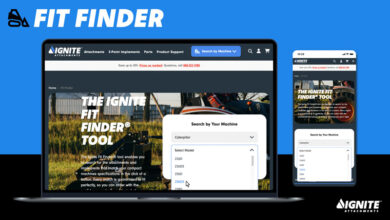Financial Reports from 4 Major OPE Brands
Four companies in the OPE market filed financial reports at the end of January or early February. Our reporting here comes from the reports presented by those companies whether online or through earnings call transcripts, as well as news reports published online by various news sources.
We present brief recaps here for:
- Caterpillar
- Stanley Black & Decker
- Polaris Industries
- Husqvarna
Caterpillar
Cat presented its 2023 year-end and Q4 financials.
Sales and revenues for the fourth quarter of 2023 were $17.1 billion, a 3% increase compared with $16.6 billion in the fourth quarter of 2022. Operating profit margin was 18.4% for the fourth quarter of 2023, compared with 10.1% for the fourth quarter of 2022.
Full-year sales and revenues in 2023 were $67.1 billion, up 13% compared with $59.4 billion in 2022. The increase reflected favorable price realization and higher sales volume, driven by higher sales of equipment to end users, partially offset by the impact from changes in dealer inventories. Operating profit margin was 19.3% in 2023, compared with 13.3% in 2022.
“I’m very proud of our global team’s strong performance as they achieved the best year in our 98-year history, including record full-year sales and revenues, record adjusted profit per share and record ME&T free cash flow,” said Caterpillar Chairman and CEO Jim Umpleby. “We remain committed to serving our customers, executing our strategy and investing for long-term profitable growth.”
Cat Financial reported revenues of $3.25 billion for 2023, an increase of $514 million, or 19%, compared with $2.73 billion for 2022. The company reported fourth-quarter 2023 revenues of $841 million, an increase of $117 million, or 16%, compared with $724 million in the fourth quarter of 2022.
During the fourth quarter of 2023, retail new business volume was $3.60 billion, an increase of $839 million, or 30%, compared with $2.76 billion in the fourth quarter of 2022. The increase was primarily driven by higher volume in North America.
This financial news helped send the manufacturer’s stock price to a record high of more than $321 in early Feb. The company’s business appears to be boosted by President Joe Biden’s $1 trillion infrastructure law that increased spending to upgrade roads, bridges and other transportation infrastructure.
Stanley Black & Decker
Reporting on Q4 2023 results, Stanley Black & Decker’s Don Allen, president and CEO, noted that “revenue was $3.7 billion, which was down mid-single digits versus the prior year, primarily due to lower outdoor and DIY volume as well as infrastructure customer destocking. Our profitability exceeded our plan as we recorded adjusted gross margin of 29.8% in the quarter. Adjusted gross margin was up over 10 points versus the prior year and improved 220 basis points versus the third quarter. As a result of our focused efforts, this is the fourth consecutive quarter that we delivered sequential adjusted gross margin improvement.”
Allen continued, “the outdoor power equipment industry continues to show signs of customer destocking, and we don’t expect to pivot to growth during 2024. In summary, we’re focused on the pro user and the healthiest market segments to generate share gains. We are prepared for weak consumer and outdoor demand trends to persist. The midpoint of our 2024 plan represents a continuation of the current demand environment, which in aggregate is slightly negative for all markets. We will remain agile and ready to serve incremental demand if it accelerates in the second half.
Polaris Industries
Polaris reported that Q4 23 for North American retail was up 7%, driven mostly by the utility and snow segments. The company said they expected positive snow performance relative to last year, but they were weaker than expected given the lack of snowfall in most regions. “It was encouraging to see our side-by-side retail up low double digits, driven by continued strength in our range of vehicles,” said Mike Speetzen, CEO of Polaris. “While utility saw strength, our recreational business continues to see pressure given higher interest rates and economic uncertainty. We ended the year gaining slightly over one point of share in Off-Road more if you exclude used vehicles that have little profitability associated with them.”
“As reflected in our outlook, segments of our industry are expected to remain challenged in 2024, but we believe we will continue to capture market share with our robust lineup and new products coming later this year,” said Speetzen.
Speetzen said the company has stabilized dealer inventory, removing the challenges of product availability they’ve been dealing with for several years, but other operational challenges need to be addressed. “Our largest challenge centered around our manufacturing facilities. We did not achieve the efficiencies we planned, which resulted in margin pressure throughout the year. It’s important to note that operational costs did start to improve later in the year, but not to the level we had expected them to. This, coupled with lower manufacturing volumes and difficulty producing new products led to significant margin pressure.”
Polaris reported worldwide sales of $2,289 million, down five percent versus the fourth quarter of 2022. North America sales of $1,995 million represented 87 percent of total company sales and decreased five percent from $2,108 million in 2022. The manufacturer said it expects 2024 sales to be down five to seven percent versus 2023. The company also says it expects adjusted diluted EPS to be down 10 to 15 percent versus 2023.
Husqvarna
Net sales for the company’s Forest & Garden Division decreased by 1% (to SEK 31,759m). Husqvarna CEO Pavel Hajman joined Terry Burke, Husqvarna CFO, in the company’s recent earnings call, to report following.
The fourth quarter was characterized by a continuous challenging market situation with lower demand. Sales of professional robotic mowers and battery-powered products were strong. However, sales of petrol-powered wheeled products decreased significantly due to lower demand and that we proactively are exiting parts of this segment.
Growth was solid in the professional segment of robotic mowers, including Husqvarna CEORA. Husqvarna Automower NERA was launched as the group’s first robotic mower to offer virtual boundary technology for the residential market.
“During the year we continued to deliver on our strategy, reinforced our positions in key segments as well as achieved an improved operating margin and a strong cash flow,” said Hajman.”
“The electrification ambition is the major driver to consistently reduce our carbon footprint. Our commitment to reducing CO₂ emission is continuing, including our exploration of products using alternative fuels. I would like to express my gratitude to all colleagues and partners for their hard work, exceptional engagement and contribution this year. We are dedicated to building a stronger Group while navigating through ongoing market uncertainties. We have cost savings and inventory management programs in place, and we are prepared for 2024, backed by a strong product lineup featuring many exciting innovative product launches.”




